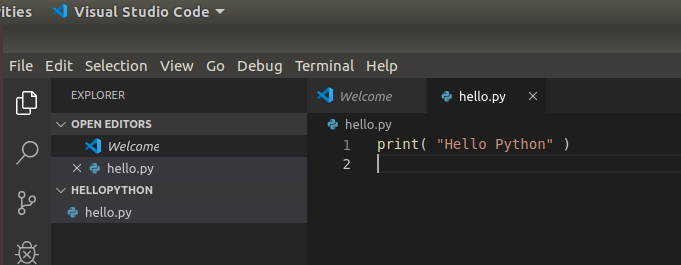
- How to update python on mac from terminal how to#
- How to update python on mac from terminal mac os x#
- How to update python on mac from terminal install#
- How to update python on mac from terminal manual#
- How to update python on mac from terminal upgrade#
I also downloaded python from the python website, and got a folder python 3.1 but when I try to type python -version in the terminal it only returns python 2.7.16.

=> Searching for a previously deleted formula (in the last month)…Įrror: No previously deleted formula found.įatal: Could not resolve HEAD to a revision => Searching for similarly named formulae…Įrror: No similarly named formulae found.

Warning: No available formula with the name “ca-certificates”.
How to update python on mac from terminal install#
If you are a Homebrew user, you may already have Python installed.I have tried to install python 3 both via homebrew and the python website. It gives Apple users a power similar to apt-get or yum. The Homebrew project provides a free and open source package manager for macOS that many people rely on. It means we have to remember to check the website and download the new files since Python doesn't include a command-line way to update. This strategy works, but it isn't ideal for making future updates to Python. bashrc: $ echo "alias python=/usr/local/bin/python3.7" > ~ /.bashrc If you are using the default Bash shell, you can append this same text to your. zshrc file: $ echo "alias python=/usr/local/bin/python3.7" > ~ /.zshrc Since I use zsh by default, I put the following into the. What's nice about an alias is that it's specific to our command-line shell. If we use the package installation, a python3 fill will be available in /usr/local/bin/.Īliasing is a must since the Python binary stored in /usr/bin/ can't be changed.

Python's website has a macOS Python 3 installer we can download and use. There are a couple options when we think about common installation patterns for applications on macOS. Now that we know what not to do, let's look at what we could do. eBook: An introduction to programming with Bash.Try for free: Red Hat Learning Subscription.Assuming you already have Homebrew on the Mac, then you can run the following command into the Terminal application to install both Node.js and npm: brew install node. Pondering Python runtimes can be comically challenging at times, as noted by XKCD. Its always a good idea to update Homebrew before installing a Homebrew package, so run the following command to do that: brew update. The version of Python that ships with macOS is well out of date from what Python recommends using for development. Now that you have your Python versions fixed, it's safe to explore why this problem confuses so many people.
How to update python on mac from terminal how to#
I mention how to use the built in venv library in the article, and Moshe recommends virtualenvwrapper for managing virtual environments. It's also essential, for dependency management, to use virtual environments. SuccessĪs you get comfortable with this workflow, you can use pyenv to manage multiple versions of Python. Using Moshe's recommendation to use a version manager (pyenv) enables us to easily accept future upgrades without getting confused about which Python we are running at a given time. Python 3.8 takes up around 100megabytes of hard drive space after install. Now, you must launch on the Python packages installer, after that install the updated Python onto your Mac.
How to update python on mac from terminal manual#
Now we know for certain that we're using Python 3.7.3 and pip will update alongside it without any manual aliasing between versions. You must first to do was, go into the main official webpage, and after that, you must download the recent version of the Python packages installer. If command -v pyenv 1 >/dev /null 2 >& 1 then While other installation options are available, the easiest way to get started is with Homebrew: This tool manages multiple versions of Python and is described as "simple, unobtrusive, and follows the Unix tradition of single-purpose tools that do one thing well." How do we stop caring about the default? Moshe recommends using pyenv to manage Python environments (for a deeper dive on configuring pyenv, see this article).
How to update python on mac from terminal mac os x#
You do not want the Mac OS X 'default Python' to be 'python3.' You want to never care about default Python." "The basic premise of all Python development is to never use the system Python. He helped 40 colleagues develop Python safely and consistently on macOS systems following one core principle: I knew Moshe was familiar with Python, but what I didn't know is that he is an author of many Python tutorials as well as an upcoming book on Python development on macOS. Moshe Zadka cautions that doing this wrong could result in an unreliable idea of which Python is running that depends too closely on shells loading aliases. Here's the full story of how to set up your environment without breaking anything built into the macOS operating system. To my surprise, I found only a handful of StackOverflow posts, and they pointed me to partial solutions. So, I did what any of us would do and googled around looking for a guide to update my development environment, which runs on Mac (the macOS operating system, formerly known as OS X). A future version of pip will drop support for Python 2.7.

How to update python on mac from terminal upgrade#
Please upgrade your Python as Python 2.7 won 't be maintained after that date.


 0 kommentar(er)
0 kommentar(er)
